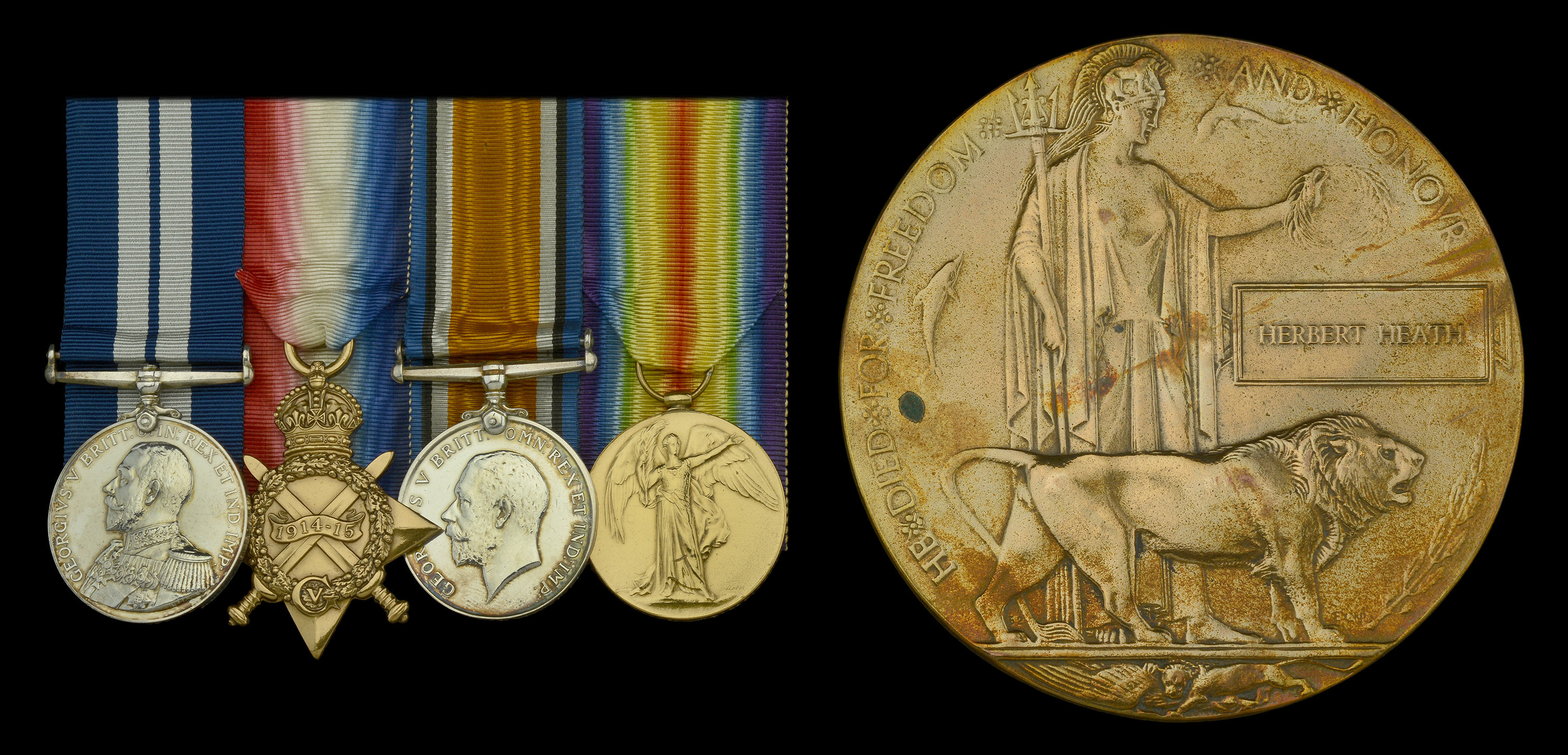A fine Great War submariner’s D.S.M. group of four awarded to Acting Leading Stoker H. Heath, Royal Navy, who was decorated for his services in H.5’s spectacular destruction of the U-51 off the Weser in July 1916; sadly, he was still serving in H.5 at the time of her loss in Caernarfon Bay in March 1918 when, mistaken for a U-boat, she was rammed and sunk by the S.S. Rutherglen Distinguished Service Medal, G.V.R. (K.946. H. Heath, Act. Lg. Sto. H.M. Sub. 14. July. 1916.); 1914-15 Star (K.946, H. Heath, Act. L. Sto., R.N.); British War and Victory Medals (K.946 H. Heath. L. Sto. R.N.) the B.W.M. officially re-impressed, together with Memorial Plaque (Herbert Heath) in its card envelope, nearly extremely fine (5) £1,800-£2,200 --- Importation Duty This lot is subject to importation duty of 5% on the hammer price unless exported outside the UK --- --- D.S.M. London Gazette 6 September 1916 Herbert Heath was born in Poplar, London on 13 February 1889 and entered the Royal Navy as a Stoker 2nd Class in July 1908. By the outbreak of hostilities in August 1914, and having volunteered for submarines, he was serving as a Stoker 1st Class in C.4, and he remained likewise employed until April 1915, when he came ashore to Dolphin. In October 1915, Heath returned to sea with an appointment in H.5, under Lieutenant C. H. Varley, R.N., then operating in the 8th Submarine Flotilla out of Yarmouth. And he was quickly called to action stations in April 1916, when Admiral Scheer mounted another of his raids against the east coast, on this occasion his battle cruisers bombarding Yarmouth and Lowestoft. But for H.5’s intervention, they may have been more costly attacks, because on spotting her periscope as she closed them, the enemy chose to beat a hasty retreat. But it was for H.5’s subsequent and spectacular attack on the U-51 in July 1916 that Heath was awarded his D.S.M. Varley had been ordered to patrol off Terschelling - an area ‘not worth a damn’ in his forthright opinion - and, so, disregarding his orders, he took G.5 off to more promising hunting grounds, his first port of call being Borkum. As it happened, Borkum was also bereft of potential targets, but, in the evening of the 13th, he sighted a flotilla of enemy destroyers. Varley dived to attack but his prey was running at speed and his torpedoes missed. Moreover, H.5’s periscope was causing problems, so much so that it took three ratings to turn it for routine sweeps. Painfully aware of the implication of his avoidance of patrol orders and his empty ‘bag’, Varley chose not to turn back and, on the morning of the 14th, his perseverance was rewarded. Edwin Gray’s Underwater War takes up the story: ‘U-51 was sighted as she left her base for an Atlantic patrol and H.5 stalked her carefully. Finally Varley closed the range to 600 yards and his torpedo blew the enemy submarine out of the water in a spectacular explosion. Anxious to obtain some evidence of his success the young Lieutenant came to the surface to pick up prisoners but German patrols which had rushed to the spot at high speed opened fore and forced him to dive. The shallow waters of the Bight nearly became H.5’s grave and, before long, the submarine was rocking under the continual detonation of depth-charges. The Germans also used a wire-sweep which the crew heard scrape along the entire length of the hull but somehow survived and Varley finally headed for home - more than a little apprehensive of his reception. Despite his success against the U-51 Varley got a rocket from his flotilla captain who, at the time, was seriously considering the possibility of having the young Lieutenant court-martialled. Varley, himself, was unrepentant and made only a half-hearted apology in his patrol report: ‘I very much regret to report my slight transgression from orders … ’ Fortunately the flotilla captain knew the strains and frustrations which his commanders had to endure and in his report to the Admiralty he showed that he, too, was on Varley’s side. ‘Lieutenant Varley is a very able and gallant submarine officer,’ he wrote, ‘and although there is no possible excuse for disregarding his orders … it is submitted that his skilful and successful attack on an enemy submarine may be taken into consideration … [and] be considered in mitigation of the offence.’ Varley remained in the Admiralty dog-house for a year until he had, ‘in Their Lordships’ view, done sufficient penance. Then in belated recognition of his gallantry he was awarded the D.S.O..’ H.5’s triumphant return to Yarmouth was notable for it being the first occasion a British submarine had been captured flying the ‘Jolly Roger’ on camera. Tragically, however - and command having devolved to Lieutenant A. W. Forbes, D.S.O., R.N. - H.5 was lost with all hands on 2 March 1918. News of that loss was first reported in a message received by Vice-Admiral Sir Lewis Bayley, Admiral Commanding Western Approaches. Ironically, the message was sent by an ex-submariner V.C., Captain Martin Nasmith, of the S.S. Rutherglen: ‘S.S. Rutherglen has rammed a submarine at 20.30 hours on the 2 March within position Lat. 53 4’ N, Long. 4 40’ W. The submarine was crossing bow at considerable speed. After collision cries were heard and men seen in the water, also there was a strong smell of petrol vapour. Forepeak of Rutherglen is flooded.’ On 28 July 1919, the British Prize Court awarded the crew of H.5 a £175 bounty for the sinking of U-51. Heath has no known grave and is commemorated on the Chatham Naval Memorial. Sold with copied research.





